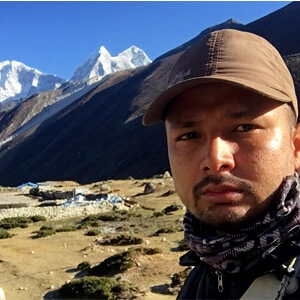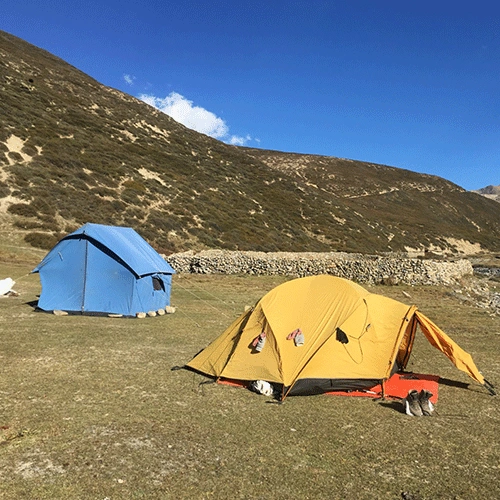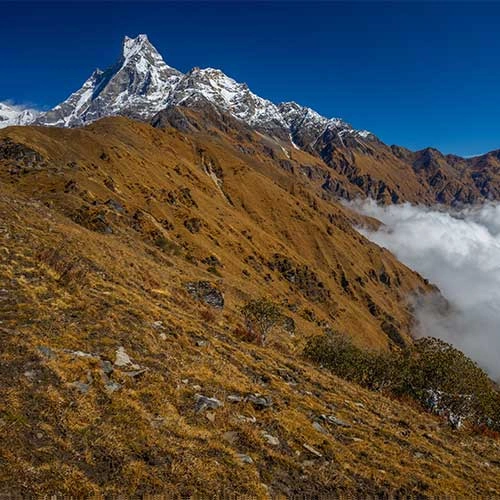The Annapurna Base Camp Overview
The Annapurna Base Camp trek is a popular destination that lies in the center of the Annapurna region. From this Base Camp, one gets startling views of the gigantic massif of Annapurna. The various landscapes, from emerald hills to rocky trails, make the journey to the base camp a really thrilling one.
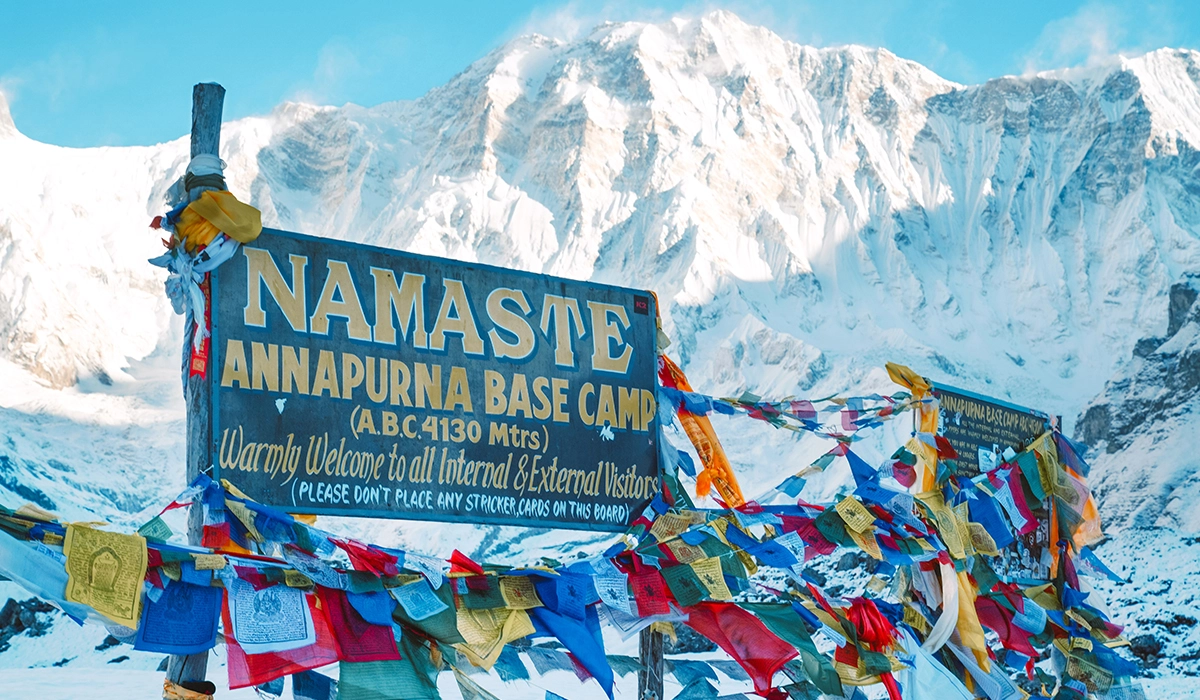
Most trekkers will start from Pokhara, where they take off. They will head into different scenic villages like Ghorepani and Chhomrong. Every village represents something unique in regard to culture and warm hospitality. During the journey, you will feel the spirit of local life, taste delicious Nepali food and enjoy breathtaking views.
While you go upwards, the topography also changes dramatically. You will pass by thick rhododendron forests, cross suspension bridges, and gaze in wonder at cascading waterfalls. Every step takes you one step closer toward the towering peak among them- Annapurna I at 8,091 meters. This grand mountain is among the highest in the world and something your eyes may never have seen.
March and April are considered the best seasons to visit Annapurna Base Camp. During this time, the weather is often clear, giving you the best views. However, be ready for chilly nights, especially at higher altitudes.
The ABC trek is not just about reaching the destination. It’s all about the moments you experience along the journey. This trek is perfect for both advanced trekkers and beginners. You will enjoy the stunning beauty of nature and connect with the local culture. Indeed, ABC is the trek of a lifetime.
The Trekking Experience
The Annapurna Base Camp Trek is supposed to be one of the most unforgettable adventures for those eager to learn about Nepalese landscapes. Starting from Kathmandu, your journey starts with a scenic drive or flight to Pokhara, which is further said to be a beautiful city by the lakeside. Further along the trail, you’ll walk through green forests, terraced farms, and lovely villages. This area shows the local culture and how people live.
Important stops on your trek include Ghorepani, Ghandruk, and Jhinu Danda. Ghorepani is popularly known for its all-round views of sunrise over the ranges of Annapurna and Dhaulagiri. Further ahead, you will be taken to Ghandruk, a Gurung village that engulfs you in its ethnicity through local hospitality and striking views of Machapuchare. Jhinu Danda presents a unique stop whereby trekkers take time off to rest their muscles, tired from long hikes, in natural hot springs.
This trek is rated as moderately difficult, so both new and experienced trekkers can join. However, don’t underestimate the physical challenge. You will face steep climbs, rough paths and long walking hours that require a good level of fitness. It’s important to prepare ahead of time with a balanced training plan. You can start improving your stamina with cardio exercises like running, cycling or swimming. Next, focus on strength training, especially for your legs. This will help you handle uphill climbs better.
The scenic diversity, cultural experiences, and sense of accomplishment make the Annapurna Base Camp Trek a bucket-list adventure for many. When you prepare well and maintain a steady pace, you will enjoy every step of this rewarding journey. The trek is also about connecting with nature and experiencing the rich traditions of the Himalayas.
Cultural Experiences
When you’re trekking to the base camp during the time of March and April, you may experience numerous saucy local ethnographies, particularly the Gurung and Magar people. This develops a unique cultural integration for the opportunities that might allow trekkers to experience customs and transitions passed on through generations firsthand.
It is very rewarding as it has allowed people to view the traditional practices of the locals, from their dressing style to their daily routine. Village trekking presents a glimpse into their way of life. As you trek through villages, you’ll also see small shrines, prayer flags, and intricate carvings that showcase the deep spiritual beliefs of the region.
The festivities of the trek include enjoying cultural high points such as local food and handmade crafts. It may fall in the month when Dashain or Tihar is celebrated, during which time villages take a rhythmic hue with music, dances, and rituals. The food on the trek forms yet another very important cultural aspect. You’ll be able to enjoy the staple dishes such as dal bhat, which comes with rice, lentils and vegetables that are mostly grown in the area.
You can also find local handicrafts, like woven fabrics and wood carvings. These items are more than just souvenirs. They show the skill and artistry that have been passed down through generations. Each such purchase you make supports the local economy and keeps those traditions alive. It will add an extra dimension to your Annapurna Base Camp Trek-merely trekking to the cultural immersion.
Essential Preparations
The journey to Annapurna Base Camp requires some careful preparation. Pay attention to physical training, mental readiness and the right gear to have a safe and fun experience. When you prepare in these ways, you’ll be ready to enjoy the stunning beauty of Annapurna Base Camp. If you plan the trip properly, you’ll make all the difference.
Physical fitness plays a very important role in successfully completing the trek. It will involve long hours of trekking through different changing landscapes. Long hours of trekking are done by passing different changing landscapes; hence, it is very important to build stamina for hiking long hours through the changing terrain. The initial exercises recommended are brisk walking, jogging and climbing stairs.
Strengthening your legs and core will make it easier for you to handle both uphill and downhill trails. Incorporating squats, lunges, and planks into your workout routine will greatly increase overall endurance. Cardiovascular exercises such as cycling or swimming build up your lung capacity and heart health, making it easier for you to cope with high altitudes.
Acclimatization is very important when you trek at higher altitudes. Take it easy and allow for some extra rest days to get used to the thin air. Try to mentally prepare yourself for the challenges that lie ahead, including rigid weather and rough trails, so you can keep your focus on the trek. You also need warm layers, rain gear and a good sleeping bag. If you travel light, consider hiring equipment in Nepal: it saves space and money. With proper preparation, the experience you will get on this Annapurna Base Camp trek is incomparable.
Safety Considerations
While trekking to Annapurna Base Camp can be an exciting and unparalleled adventure, safety is the issue that absolutely should come to the fore. The present trek encompasses high altitude, uneven terrain, and unpredictable weather conditions. Hence, cognizance of its key aspects is vital for a smooth and enjoyable experience. Important factors that will help one stay safe on this journey need to be overviewed.
First and foremost, altitude sickness is very common during trekking in the Himalayas. During your ascend, you might develop headaches, dizziness, and shortness of breath. To avoid this, acclimatize yourself properly by ascending at a slow pace, hydrating yourself regularly and avoiding alcohol consumption altogether. Be extra attentive to your body and never overexert yourself if symptoms begin to show up. Understanding the early signs and knowing how to manage symptoms are the ways to prevent severe issues of altitude sickness.
Besides altitude awareness, other practical safety tips during the trek include drinking a lot of water to avoid dehydration, which adds to the altitude effects. Setting a reasonable pace to avoid getting too tired and experiencing exhaustion. The dressing is in multiple layers to regulate changing temperatures. It always has appropriate gear with you. It also includes sturdy footwear and a first-aid kit. Never trek alone and always stick with a group or hire an experienced guide for extra safety.
Lastly, study some emergency procedures. Know the placement of health posts along the route. Carry important contact numbers with you, like local rescue services and your embassy, in case of emergencies. Reception for mobile phones is limited, so you might even consider carrying a satellite phone in case of an emergency. In view of these safety considerations, one can have a rather enjoyable Annapurna Base Camp trek with minimal risks. Thus, plan in wisdom to stay alert and follow these steps for a safe and memorable journey.
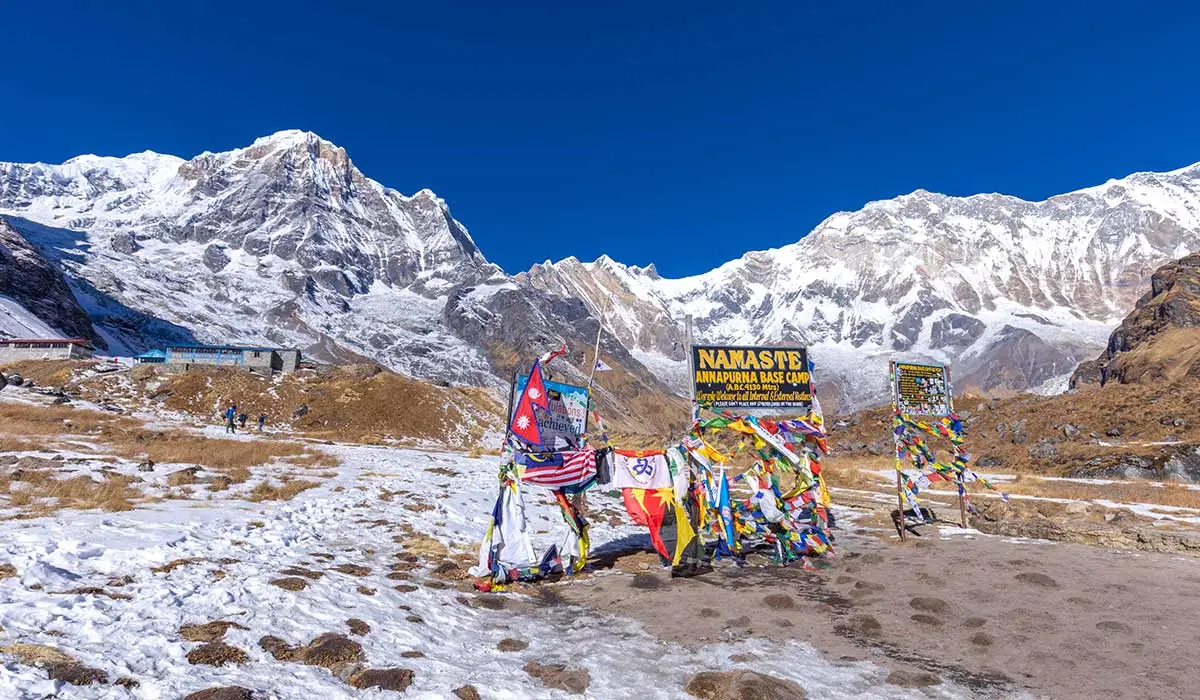
Environmental Awareness
Environmental protection should be given priority during your trekking journey. Many trekkers come to this area, so it’s important to be careful about how you travel. This way, you can help keep the region beautiful for future generations. Practiced responsible travel ensures that the beauty of Annapurna is not tampered with.
When we talk about sustainable trekking practices, responsible trekking means making choices that help the environment. You do this through simple actions, like supporting local businesses and not using single-use plastics, amongst other things, and greatly reducing impacts on natural environments. Respect local culture and nature, too; in this way, you preserve the area. Through responsible trekking, you will contribute positively to the region.
To trek in an eco-friendly way, be mindful of the environment. This will automatically help you care for and protect nature. Bring your refillable water bottles, bags and utensils to minimize generating waste. Always keep on the paths and never disturb the wildlife or change the landscape. Take advantage of the greener options available to you around the campsite. Always clean up after yourself. Never leave a trace behind. These simple actions can help protect our beautiful planet.
For principles of leaving no trace, a key rule for responsible trekking is "Leave No Trace". You should leave the environment just like how you found it or even cleaner. Always take your trash with you. Also, avoid picking flowers and disturbing wildlife. By keeping campsites clean, you help others enjoy the beauty of nature, too.
The main aim of responsible tourism is to protect the environment and support local communities. Use environmentally sensitive accommodations and consider tour operators that have adopted sustainable practices. In return, you will help protect Annapurna's fragile ecosystems and help the people who live there.
Why choose March and April for Trekking?
March and April months have excellently pleasant weather conditions. A picturesquely beautiful Himalayan backdrop and less crowding of the trails. They are very good months for tourists who seek to enjoy the natural beauty of Nepal but avoid the hustle and bustle of the peak season.
During summer and springtime, the days are longer than the nights. More daylight hours mean you can trek at a relaxed pace and enjoy warmer afternoons and bright mornings. You may still see some snow in higher areas in March. Light spring showers start by April, but that won't affect much of your trek. It's a chance to enjoy both snow and fresh greenery.
The good temperatures make for comfortable weather conditions. The daytime temperatures range between 10°C to 20°C, which makes trekking comfortable. At night, it gets colder, especially in higher areas. The temperature may go down to almost about 0°C.
The other reason is the flora and fauna found during these times, such as spring flowers and birdwatching. If you are interested in birds, spring is a great time to see some of the very rare species. In many areas like Annapurna, many birds come back in this season, so it is perfect for bird watching.
The trails are significantly calmer during March and April compared to the busy months of October and November. Fewer trekkers mean space to yourself both on and off the trail. This means a serene experience where you can take in the natural beauty without a lot of distractions.
What to Expect on the Trek?
Hiking in March and April, one might find different conditions on the trails. The route is steep with major ascents and descents, which can be tricky at times and may be especially difficult for those not accustomed to being on rocky trails. Close to base camp, there will be snow and ice. Early-season snows can affect the trail since parts will be quite dicey.
You’ll find all kinds of simple rooms and basic facilities of teahouses. Most of the teahouses offer basic facilities, shared bathrooms, and hot showers, readily available during the months of March and April. Most meals are local, comprising dal bhat, soups, and tea, which is very filling for trekkers. This is not to mention hygiene and health concerns in the teahouses. Always check that the water you drink is clean. Also, make sure that your meals are safe to eat.
Cultural attractions on the route add texture to your trek. You get to experience the local communities like Gurung and Magar people. You’ll learn about their way of life and traditions. These interactions make the trek even more special. Besides, visits to various religious and cultural attractions, such as temples, stupas, and mani walls, provide a glimpse into the spiritual heritage of this region.
Communication and connectivity can vary. While several teahouses do have Wi-Fi available, the signal might be poor. It's smart to have a backup plan if you rely on mobile networks for navigation or communication. Generally speaking, every teahouse will have the facility to charge your electronic gadgets, although availability in extremely remote areas may be limited.
Tips for a Successful Trek in March and April
The trekking is best in March and April, but to have the most adventurous experience, one needs to be prepared in advance before commencing on this journey. Hence, after mentioning a few tips and tricks, the person will become ready for a safe and successful trek and enjoy it fully without any hesitation.
Beat the Weather by Starting Early: Start early to capitalize on daylight. Cover more ground starting at dawn before the heat sets in. Spring afternoons may have rain, so finishing off by early afternoon is a good idea.
Dress in Layers: Mornings get a bit chilly, but afternoons are warm.Dress in layers to stay comfortable. Begin with a base layer that wicks sweat away from your skin. Then, put on a fleece over this to warm up. Lastly, wear a waterproof jacket over them in case of sudden rain. That way, you will feel at ease throughout the day.
Hydrate and Eat Well: Drink lots of water throughout the day. Drink two to three liters of water every day. This helps stop headaches and keeps you from feeling tired. Additionally, you can bring nuts, energy bars and dried fruits to stay energized during the trek.
Use Gear Smartly: Trekking poles help with balance and reduce pressure on your joints, especially on rough paths. Pack light by carrying only what you need, and use gear that serves multiple purposes. A lighter load makes your trek easier and more fun.
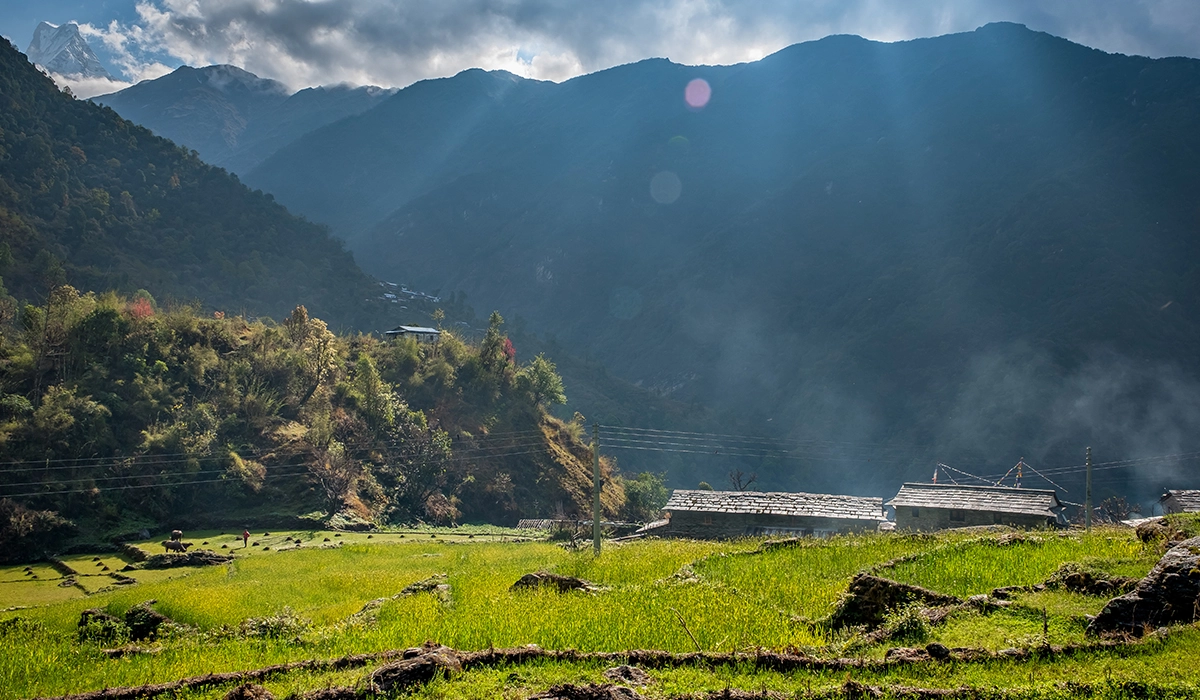
Cultural Encounters
The trek offers a unique cultural experience the moment you land in Kathmandu. Especially in the months of March and April, the weather is pleasantly wonderful, yet you’ll experience less crowd on the trails.
The walk through the villages is quite often very friendly where the locals are encountered. Most of them are farmers or guides in their villages. Nepalese people really take great pride in their heritage. You may also get a view of some of the traditional farming practices, such as planting rice or tending to the animals. You are at liberty to ask any question that may come to your mind. Usually, locals will be able to explain their way of life.
Various festivals are also held in March and April. You can also enjoy the Nepali New Year, popularly known as "Bisket Jatra," which is famous among locals in the Bhaktapur district of Nepal. It is celebrated as a festival where people gather together to pull a chariot with images of different gods through the streets. Along the way, there is music, dancing and lots of celebrations. All the colorful processions and traditional dances accompany this festival. Participation will remain a lifetime experience. You will see the vibrant traditions of the Gurung and Magar communities.
Another very important part of the culture is food. Teahouses along the trek will serve you local food, like dal bhat and momo. Sharing meals in a group with other trekkers and locals warms the atmosphere. It is a great experience to connect to nature through shared experiences. You will also see beautiful praying flags and stupas on the way, reflecting the spiritual beliefs of the local people. Many trekkers pause to enjoy the calm surroundings and join in simple rituals. This adds to the cultural richness of your journey. The trek to Annapurna Base Camp in March and April offers the most beautiful views. It is rather the good local culture encounters, festivals, and shared meals that make your trek truly unforgettable.




